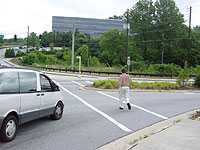Worksite Walkability
Are your employees walking at work?
Evidence suggests that most Americans need to get more physical activity. Two-thirds of people in the United States weigh more than they should and nearly three-quarters don't get the recommended 30 minutes of physical activity on most days. Because many adults spend 20, 30, or 40 hours or more a week at work, adding physical activity to employee's workdays may be one way to help working Americans become healthier.
Walking or biking to work is one way to increase physical activity, but for many people it isn't an option. However, for many employees, walking while at work is a way to increase their physical activity. But how safe and attractive is the walking environment at your work place? To find out, use our walkability audit.
 What is Walkability?
What is Walkability?
Walkability is the idea of quantifying the safety and desirability of the walking routes. At work, these can be streets and sidewalks in between buildings on your campus, city blocks if you work in a downtown area, or even walking or nature trails at your work. Many people work on campuses that have more than one building, and they might work in one building and have meetings in another. Do your employees walk to those meetings, or drive? Do they walk for exercise or recreation at lunch or during breaks? Do they walk to restaurants or parks to have lunch? Sometimes people don't walk at work because they don't feel that the walking routes are safe or convenient.
There is scientific evidence that providing access to places for physical activity increases the level of physical activity in a community.1 The Task Force on Community Preventive Services strongly recommends creating or enhancing access to places for physical activity, in conjunction with a well-run communication and marketing campaign. A typical study of an intervention to create or enhance access to places for physical activity reports a 25% increase in physical activity levels.2
What is a Walkability Audit?
A walkability audit tool is designed to broadly assess pedestrian facilities, destinations, and surroundings along and near a walking route and identify specific improvements that would make the route more attractive and useful to pedestrians. Using CDC's Walkability Audit from this site can help you assess the safety or attractiveness of the walking routes at your worksite.3 The audit helps you map out the most commonly used walking routes, and helps you identify the most common safety hazards and inconveniences that can keep employees from walking at work.
Audit Tool
Download the audit tool and instructions for use at your worksite.
Glossary
Learn some of the most common terms used in discussing worksite walkability.
Example
See an example of a completed worksite walkability audit.
Selected References
Read articles written about community walkability.
References
1Creating or Improving Access to Places for Physical Activity is Strongly Recommended to Increase Physical Activity. The Task Force on Community Preventive Services. Available at http://www.thecommunityguide.org/pa/default.htm
2Ibid
3Dannenberg, A.L., Cramer, T.W., & Gibson, C.J. (2005). Assessing the Walkability of the Workplace: A New Audit Tool. American Journal of Health Promotion, 20 (1): 39–44.
- Page last reviewed: September 4, 2015
- Page last updated: September 4, 2015
- Content source:



 ShareCompartir
ShareCompartir